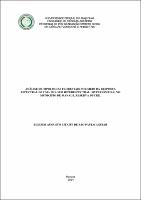| ???jsp.display-item.social.title??? |


|
Please use this identifier to cite or link to this item:
https://tede.ufam.edu.br/handle/tede/4710| ???metadata.dc.type???: | Dissertação |
| Title: | Análise de tipologias florestais por meio da resposta espectral de uma imagem hiperespectral (Hyperion/eo-1) no município de Manaus, Reserva Ducke |
| ???metadata.dc.creator???: | Aguiar, Eliezer Augusto Litaiff De São Paulo  |
| ???metadata.dc.contributor.advisor1???: | Costa, Lizit Alencar da |
| ???metadata.dc.description.resumo???: | O sensoriamento remoto hiperespectral permite obter medidas radiométricas de um alvo em um grande número de estreitas bandas espectrais. Os dados coletados por estes sensores podem ser transformados em informações sobre diferentes coberturas vegetais que estão relacionadas com aspectos biofísicos da vegetação. Sendo a vegetação um importante elemento dos ecossistemas, seus estudos ganham ênfase, sobretudo, por buscarem conhecimentos acerca de suas variações, padrões distributivos, ciclos, modificações fisiológicas e morfológicas. Com isso foi utilizado dados do sensor Hyperion que possibilita a aquisição de dados com resolução espectral suficiente para reconstruir bandas de absorção nos espectros dos pixels relacionados com o conteúdo de clorofila, teor de água nas folhas e feições de lignina e celulose, as quais podem ser parâmetros importantes na diferenciação de tipologias vegetais. Por outro lado, a pobre relação sinal-ruído (SNR) do sensor, especialmente no SWIR, é um obstáculo para a medição adequada dessas feições sem a interferência de ruídos. Esta pesquisa teve como objetivo realizar uma análise da resposta espectral do sensor Hyperion com as comunidades vegetais presentes na Reserva Ducke (Floresta de platô, declividade, campinarana e baixio) e quantificar por meio de classificação não-supervisionada essas comunidades. Utilizando o aplicativo FLAASH do ENVI, foi realizada a correção atmosférica baseando-se no modelo de transferência radiativa MODTRAN-4. Na caracterização florística da área de estudo foi levantado estudos relacionados referente a flora da Reserva. Foi possível realizar uma análise sucinta das características das respostas espectrais, pois o sensor apresente uma interação com a vegetação entre o Infravermelho próximo (0,7 - 2,5μm) e o Infravermelho médio (3 - 6μm), onde podemos distinguir o estágio de fenologia, estrutura do dossel e quantidade de água na folha nas quatro comunidades vegetais. |
| Abstract: | Hyperspectral remote sensing allows for radiometric measurements of a target in a large number of narrow spectral bands. The data collected by these sensors can be transformed into information about different vegetation covers that are related to biophysical aspects of vegetation. Vegetation being an important element of ecosystems, their studies gain emphasis, especially for seeking knowledge about its variations, distributional patterns, cycles, physiological and morphological changes. With this data was used Hyperion that enables the acquisition of data sufficient to reconstruct absorption bands in the spectra of the pixels associated with the chlorophyll content, water content in leaves and features of lignin and cellulose spectral resolution, which may be important parameters in differentiating vegetation types . On the other hand the poor signal to noise ratio ( SNR) of the sensor, especially in the SWIR, relationship is an obstacle to proper measurement of these features without interference from noise. This research aimed to conduct an analysis of the spectral response of the sensor with the Hyperion plant communities present in the Ducke Reserve (Forest plateau, slope, and lowland campinarana) and quantified by means of unsupervised classification of these communities. Using ENVI Flaash application, atmospheric correction was performed based on the radiative transfer model MODTRAN - 4. Floristic characterization of the study area was raised regarding esttudos related flora of the Reserve. It was possible to perform a summary analysis of the spectral characteristics of the sensor as present an interaction with vegetation between the near infrared (0,7 - 2,5μm) and middle infrared (3 - 6μm), where we can distinguish stage of phenology, canopy structure and water content on leaf responses in four plant communities. |
| Keywords: | Sensoriamento Remoto Hiperespectral Hyperion Reserva Ducke Hyperspectral Remote Sensing Ducke Reserve |
| ???metadata.dc.subject.cnpq???: | CIÊNCIAS AGRÁRIAS: RECURSOS FLORESTAIS E ENGENHARIA FLORESTAL |
| Language: | por |
| ???metadata.dc.publisher.country???: | Brasil |
| Publisher: | Universidade Federal do Amazonas |
| ???metadata.dc.publisher.initials???: | UFAM |
| ???metadata.dc.publisher.department???: | Faculdade de Ciências Agrárias |
| ???metadata.dc.publisher.program???: | Programa de Pós-graduação em Ciências Florestais e Ambientais |
| Citation: | AGUIAR, Eliezer Augusto Litaiff de São Paulo. Análise de tipologias florestais por meio da resposta espectral de uma imagem hiperespectral (Hyperion/eo-1) no município de Manaus, Reserva Ducke. 2014. 64 f. Dissertação ( Mestrado em Ciências Florestais e Ambientais) - Universidade Federal do Amazonas, Manaus, 2015. |
| ???metadata.dc.rights???: | Acesso Aberto |
| URI: | http://tede.ufam.edu.br/handle/tede/4710 |
| Issue Date: | 16-Apr-2014 |
| Appears in Collections: | Mestrado em Ciências Florestais e Ambientais |
Files in This Item:
| File | Description | Size | Format | |
|---|---|---|---|---|
| Dissertaçaõ- Eliezer Augusto Litaiff De São Paulo Aguiar.pdf | Dissertaçaõ- Eliezer Augusto Litaiff de São Paulo Aguiar | 2.22 MB | Adobe PDF |  Download/Open Preview |
Items in DSpace are protected by copyright, with all rights reserved, unless otherwise indicated.




